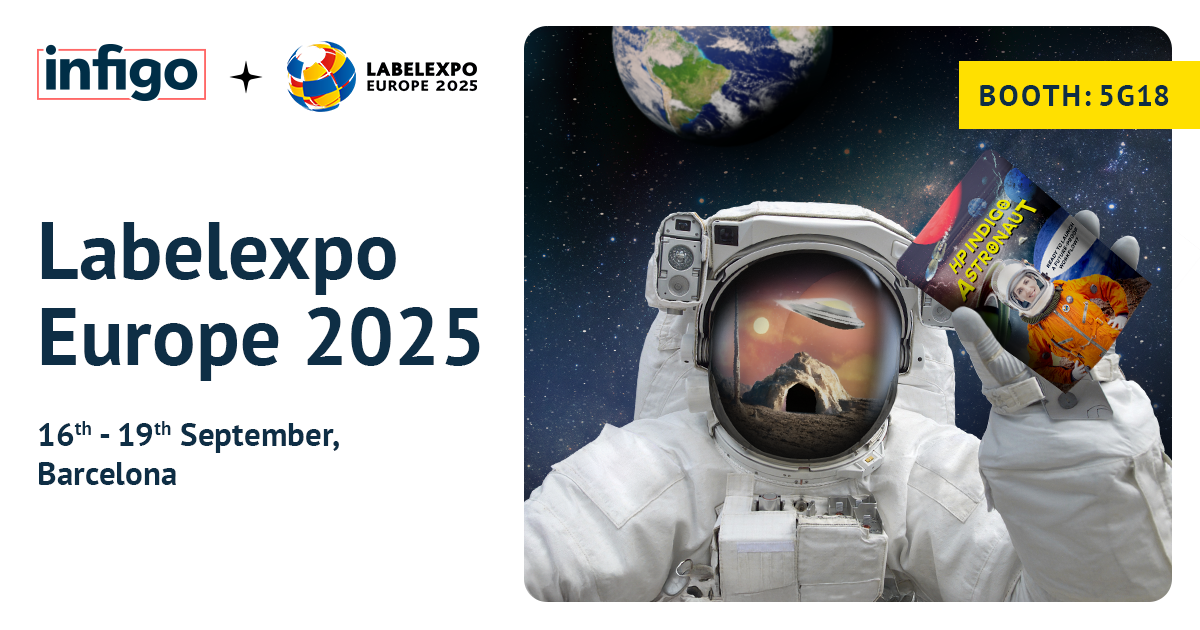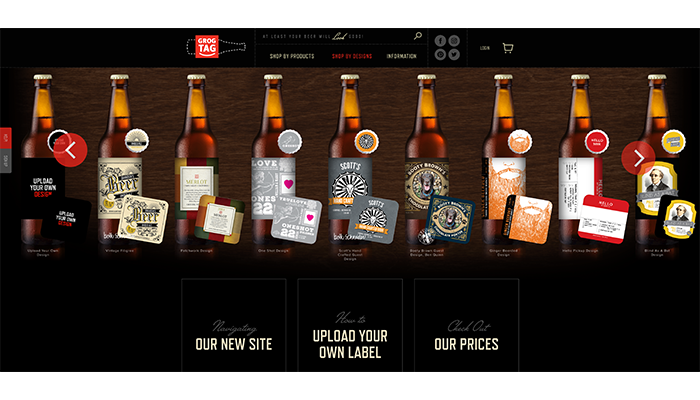Labels. The final frontier. Well, perhaps not, but in the world of printing, it’s a sector that’s experiencing explosive propulsion and is ripe for exploration.
However, before your label operation has lift-off, you need to ensure you have the right tech to get ahead of your competitors. Otherwise, you’ll be left behind in the label space race and won’t get off the launchpad.
In this blog we discuss:
- The predicted flight path for the label sector in the coming years – how much growth is on the radar?
- The trends driving increased demand for labelling
- The sectors driving this demand
- Why web-to-print technology will enable your business to reach for the stars
- Avoiding system failure: what to look for in a leading web-to-print provider.
Mission Briefing: Label Demand Reaching the Stratosphere
Strap in, space cadets. The countdown has begun, the engines are firing, and the labelling sector is reaching optimum trajectory.
According to Grand View Research, the label sector was valued at $5,270 million in 2024 and is projected to reach $8,111.1 million by 2030, growing at a CAGR of 7.5% from 2025 to 2030.
But, Houston, we have a problem: while demand is soaring, payloads are getting lighter. There’s a rising appetite for smaller, highly customised label orders. But many print and labelling companies are still effectively using Cold War technology in a 21st Century space race.
This means that if you’re relying on outdated technology and clunky manual processes, you could be losing significant revenue opportunities – the oxygen tanks of your business.
So it’s imperative that mission control has the latest web-to-print technology at its fingertips to ensure mission success.
Perfect Flight Conditions – What’s Fuelling Demand?
There are several mega-trends creating the perfect atmosphere for a foray into the labelling sector.
Sensor readings show that:
- Population growth is fuelling consumption on a planetary scale.
- An aging global population is increasing demand for medical and healthcare labelling.
- E-commerce expansion is driving up delivery packaging – and label demand – exponentially.
- Rise of the microbusiness is reshaping the customer base – and what they need from their printers.
- Brand loyalty is plummeting, while demand for personalization is climbing fast.
- Street food and indie brands are taking off – and they all need packaging with personality.
And there’s one common thread running through all of this: flexibility wins. The demand is for short runs, faster turnarounds, personalized designs. But static workflows can’t keep up.
Sample Analysis: Trends Under the Microscope
Population Growth = More Packaging, More Labels
The global population hit 8 billion in 2022, with particularly fast growth in emerging markets. That means more products, more packaging, and more labelling – particularly in sectors like cosmetics, food, and pharma.
Pair that with a rapidly aging population (2.1 billion people will be over 60 by 2050), and you’ve got rocket fuel for the healthcare labelling sector. Think medicine bottles, pill boxes, care products – each requiring precise, compliant, and increasingly personalized labels.
The Smartphone Gives Developing Economies a Turbo Boost
Emerging markets like India, China and Brazil are shifting into high gear. Urbanisation, disposable income, and digital access are all increasing – and so is e-commerce penetration.
Millions of new internet users means millions more product shipments. Which means? Yep – millions more labels.
The global beauty and personal care products market size alone was estimated at $557.24 billion in 2023 and is projected to reach a dizzying $937.13 billion by 2030, growing at a CAGR of 7.7% from 2024 to 2030, largely driven by rocketing demand in emerging economies.
E-Commerce Continues to Break New Frontiers
This isn’t just a trend – it’s a paradigm shift. Between 2014 and 2020, global e-commerce exploded from $1.3 trillion to $4.1 trillion. It now sits at $5.7 trillion globally, with no signs of deceleration.
As online orders rocket, the humble label is doing more heavy lifting than ever. Addressing. Branding. Tamper-proofing. Tracking. Communicating.
But remember: e-commerce demands speed, accuracy, and flexibility – especially when B2B buyers expect the same seamless experience they get from Amazon.
Brand Loyalty Is Fading… But Customization Is Thriving
Today’s consumer wants personalization, uniqueness, and connection. From Etsy sellers to indie food vans to boutique coffee roasters, smaller players are now big business.
And how do they brand their products? Often with nothing more than a label.
Stickers have become a storytelling device. A chance to show off sustainability, communicate values, or add humour. But they must be affordable, on-demand, and tailored.
That’s where traditional print workflows hit a black hole. And where web-to-print enters orbit.
Web-to-Print – Your Onboard Navigation System to Success
So how do you harness this label boom without mission-critical systems going into meltdown? Enter your new co-pilot: web-to-print software.
Web-to-print lets you easily create online storefronts, or portals, where clients create, customize, and order labels online. Whether they’re uploading a pre-made design or editing a template, the process is seamless.
Simple jobs? Fully automated. No more back-and-forth. Files go straight to print, guided by dynamic preflighting – so your customer can’t submit a flawed design. No more brand guideline nightmares or production bottlenecks.
By connecting to your MIS and other systems (like shipping or payment gateways), everything from quoting to delivery can be automated. Fewer errors. Faster turnarounds. Lower costs.
Out of this World Success Story
GrogTag: Powering Personalization for America’s Craft Brewers
Based in Sacramento, California, GrogTag has tapped into the booming craft beer, homebrewing, and boutique winery scene. Founded by passionate homebrewers, the company set out to make it easy for small breweries and vineyards to design and order their own labels online.
The Mission:
According to Front-End Developer Dave Blois, GrogTag’s old platform was holding them back. “It was rigid. Customers wanted to add a single line of text or swap in a photo, and they couldn’t,” he says. Managing several disconnected systems also made the process slow and hard to maintain. The team needed a single solution: a powerful web-to-print platform that could also act as a CMS, an admin hub, and an e-commerce engine.
The Infigo Solution:
GrogTag partnered with Infigo for its flexible web-to-print tools and ease of use. “It has made web-to-print simpler and more powerful,” Dave explains. “We can launch storefronts faster and integrate directly with our MIS and shipping through HP SiteFlow. Orders flow automatically through production, removing a ton of manual work.”
Mission Success:
Now, GrogTag’s customers can unleash their creativity. “We’ve given them freedom to personalize and they’ve run with it, creating some really wild stuff,” Dave says. The platform’s flexibility and support have not only improved efficiency but also delighted their customers. “Infigo gave them that extra bit of freedom they were missing—and we’d absolutely recommend it to others.”
Open Communication Through Integration
Web-to-print is only one piece of the puzzle. The real power comes from integration.
When your CRM, MIS, shipping software, and design tools all communicate, your business becomes one seamless machine.
Here’s how it looks:
→ Customer places a label order online
→ Web-to-print validates the file and confirms branding
→ Details flow into your MIS (no data rekeying)
→ Order joins the print queue
→ File is auto-processed
→ Shipping label is generated and sent to your courier
→ Customer receives tracking info, without you lifting a finger
It’s not sci-fi. It’s smart business, run on autopilot🚀
24/7 Printing with AMS Print: Unlocking Web-to-Print Efficiency
For over 30 years, Washington State’s AMS Print has grown from a small mail and shipping business into the region’s leading digital printer and commercial label producer. Seeking to increase order volume and streamline workflows, AMS implemented Infigo’s web-to-print platform.
The Mission:
Despite using HP Indigo presses and Siteflow automation, AMS’s order intake process was still not reaching the potential they knew they had. A recommendation came from HP Indigo themselves for AMS to look into Infigo. “Offering web-to-print has impacted both the business and our clients,” says Phillip Flores, Label Department Production Manager. “Our clients like the option of logging in and uploading new files or reordering previous jobs [by themselves].”
The Infigo Solution:
Integrating Infigo with HP Indigo and Siteflow enabled AMS to launch its first web-to-print powered storefront. “The fact that Infigo sends print-ready files directly to HP Siteflow has been a key improvement, allowing orders to flow seamlessly into production.”
Mission Success:
AMS now averages 3 to 8 orders per day, ranging from 5K to 100K labels. Flores calls the platform “a game changer,” with clear and concise work orders that streamline the entire production process.





